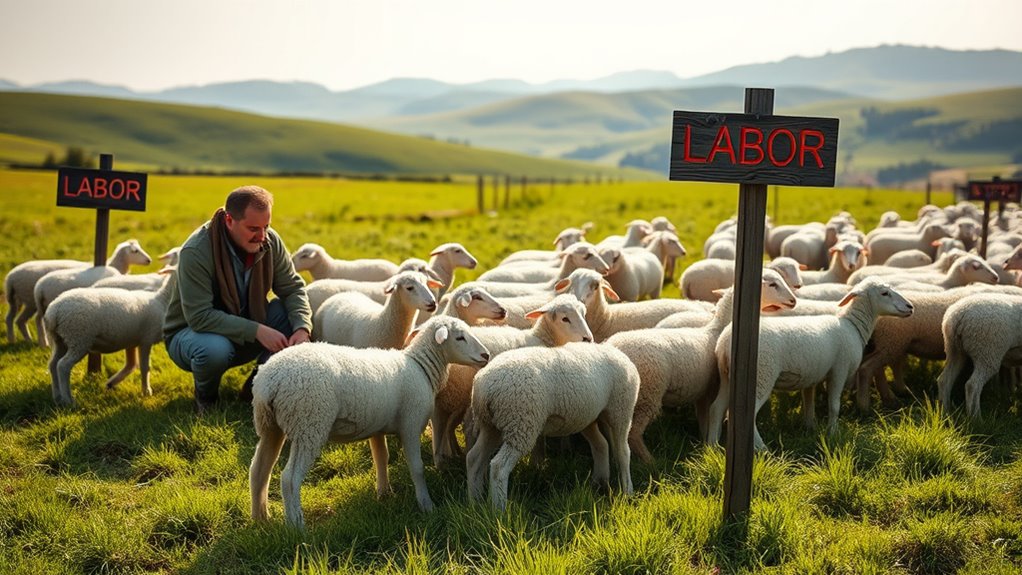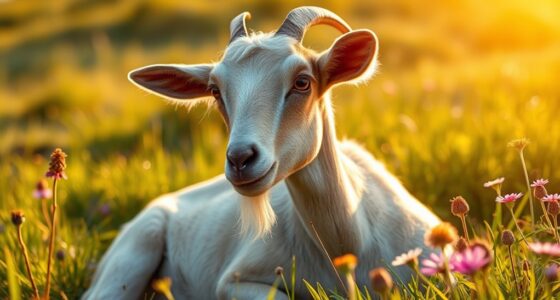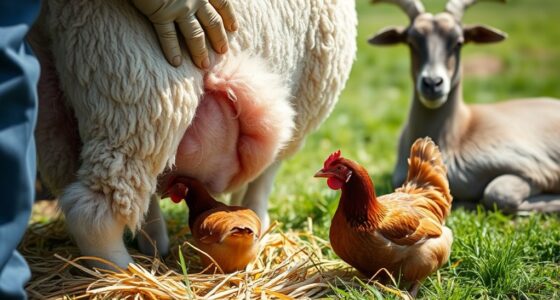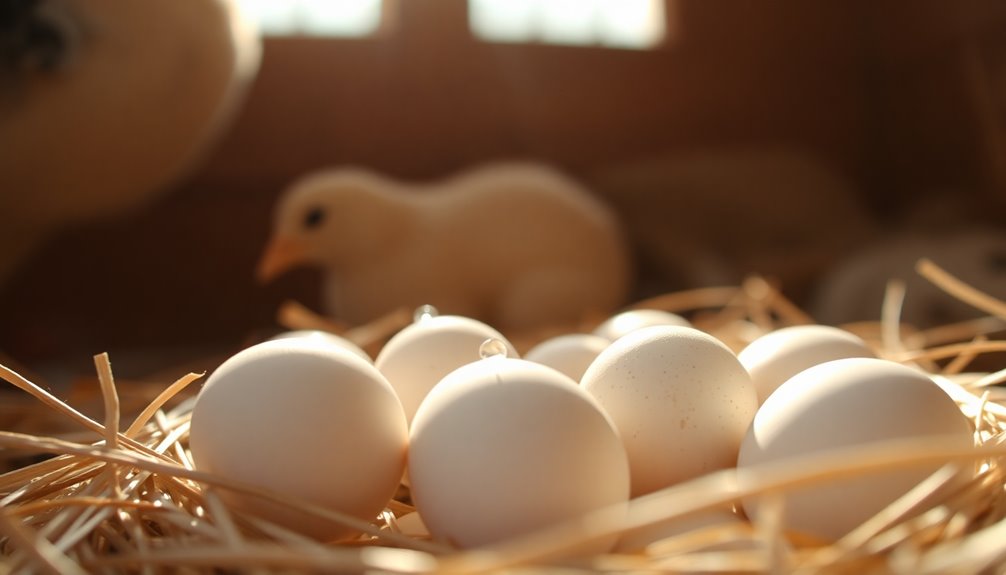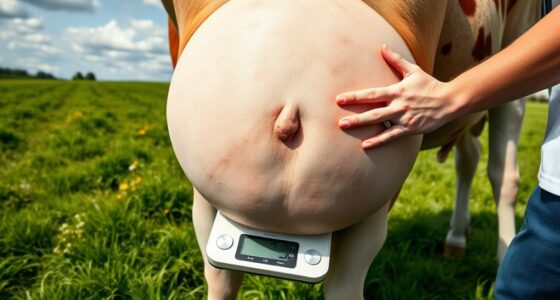When preparing for lambing, it's essential to recognize labor signs in ewes. Look for behavioral changes like increased restlessness, reduced appetite, and isolation from the flock. Physical indicators include a swollen vulva, developed udder full of colostrum, and noticeable contractions. Keep an eye on lamb presentation, and don't hesitate to assist if needed. Addressing these signs early ensures the health of both the ewe and her lambs, and there's more crucial information ahead!
Key Takeaways
- Watch for behavioral changes like reduced feeding and increased restlessness as signs of impending labor in ewes.
- Look for physical indicators such as swollen vulva, distended teats, and pronounced abdominal contractions.
- Monitor for mucous discharge and increased pacing, which signal cervical dilation and labor progression.
- Prepare for lambing by providing a clean, sheltered area for ewes to give birth privately.
- Ensure post-lambing care includes checking lambs' breathing and promoting bonding with the ewe immediately after birth.
Recognizing Early Signs of Labor in Ewes
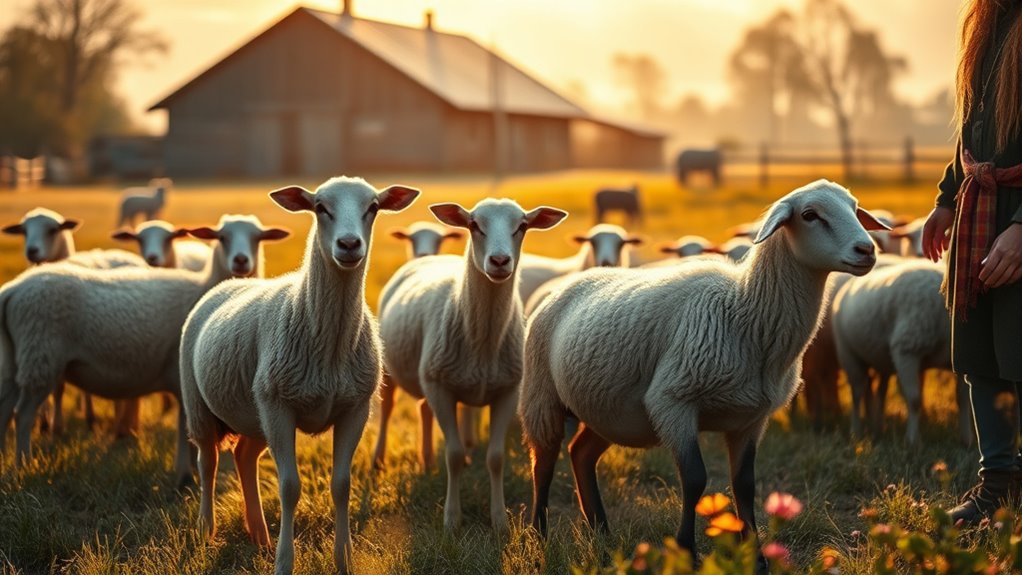
Recognizing early signs of labor in ewes is crucial for ensuring a smooth lambing process.
You'll notice behavioral changes like reduced interest in feeding and increased restlessness. Ewes may isolate themselves from the flock, avoiding both other sheep and people. As they prepare for labor, they might start pawing at the ground, grunting, or looking behind them frequently.
Look for physical indicators such as a swollen vulva and distended teats, along with hollow appearances just in front of their hips. Increased pacing and restlessness are key signs that labor is approaching.
Keeping a close eye on these behaviors helps you provide necessary support during this critical time, ensuring both ewe and lamb remain healthy and safe.
Physical Indicators of Labor Progression
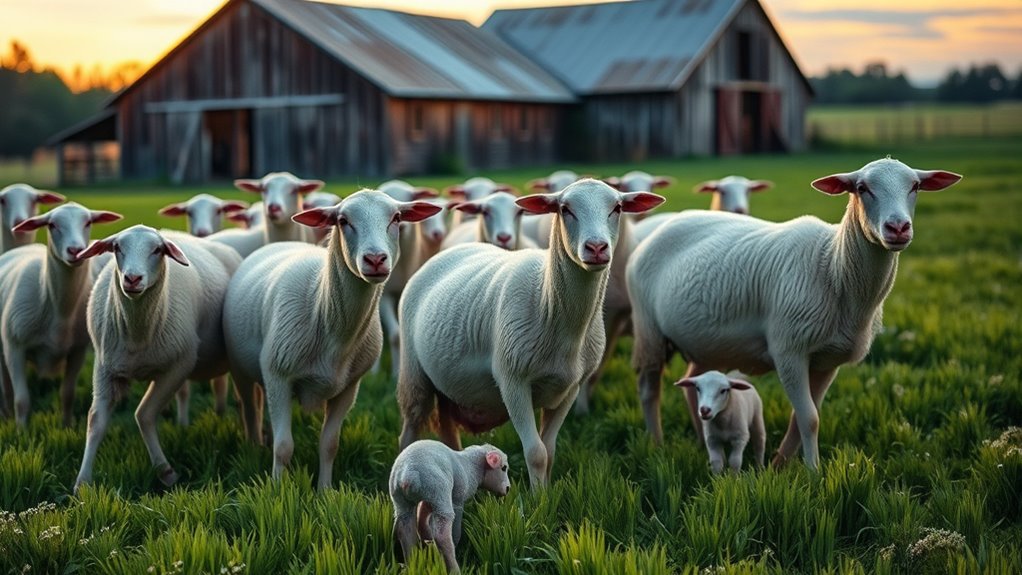
As labor progresses, several physical indicators can help you assess the ewe's readiness to lamb.
First, watch for udder development; a full, firm udder filled with colostrum signals that lambing is near.
Observe udder development; a full, firm udder indicates that lambing is imminent.
Next, observe the vulva; it swells and darkens a few days before birth, especially in ewes with lighter skin.
You'll also notice abdominal contractions becoming more frequent and intense, often causing the ewe to arch her back.
Mucous discharge may appear, indicating cervical dilation and labor progression.
Lastly, keep an eye on lamb presentation; ideally, the lamb's head and forelimbs should emerge first.
If progress stalls for over 30 minutes, be ready to assist, ensuring a smooth delivery.
Behavioral Changes During the Labor Process

Labor in ewes isn't just marked by physical signs; their behavior also shifts significantly as they prepare to lamb.
You'll notice ewes isolating themselves, showing reduced appetite, and pawing the ground as they create a nesting area. Restlessness and pacing become common, and they might avoid human interaction.
As labor approaches, ewes frequently lie down, decreasing their walking. You'll see visible contractions, along with shuffling or circling due to discomfort.
Ewes often seek out sheltered corners for privacy, and they may exhibit defensiveness towards other animals after lambing.
Watch for signs like lip curling and increased breathing, as these indicate the ewe is nearing the labor process.
Recognizing these behavioral changes is crucial for ensuring a smooth lambing experience.
Understanding the Stages of Lambing
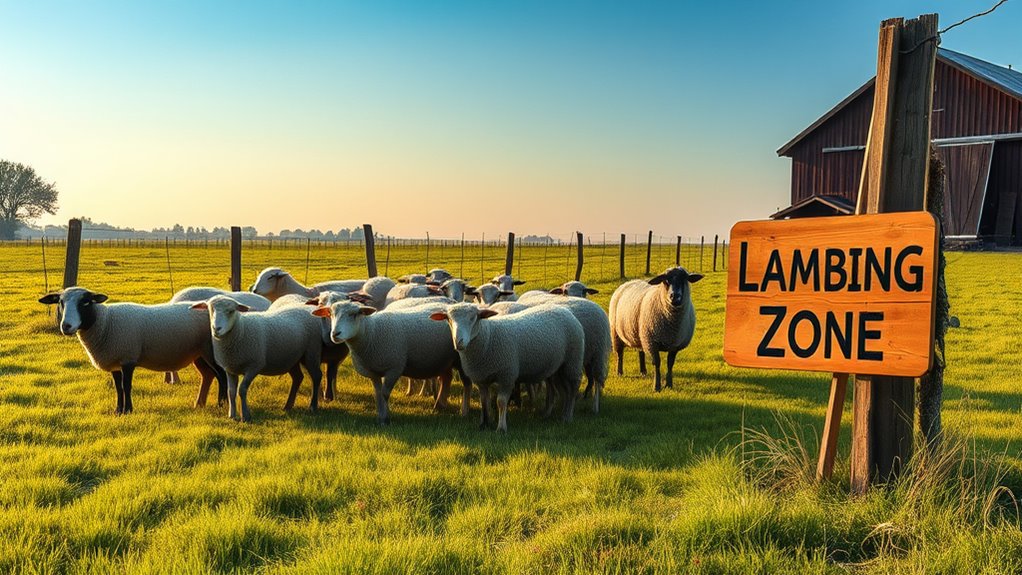
Understanding the stages of lambing is essential for any shepherd, especially since each phase plays a critical role in the health and well-being of both the ewe and her lambs.
The gestation period lasts about 144 to 150 days. Before labor, you'll notice pre-labor signs like decreased appetite and vulva swelling.
As labor begins, look for early signs such as lip curling and mucous discharge. The water bag will appear shortly before birth, followed by strong contractions and pushing.
It's vital to ensure the lamb is breathing and initiate bonding with the ewe immediately after birth.
Keep an eye on any complications, as timely intervention can make a significant difference in outcomes for both the ewe and her newborns.
Preparing Your Facilities for Lambing Season
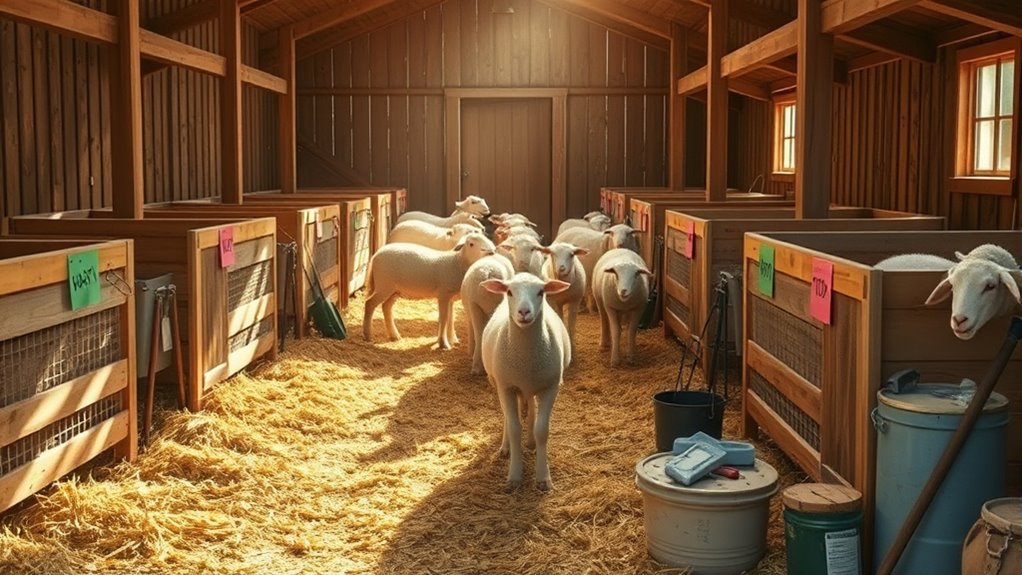
Preparing your facilities for lambing season is crucial to ensure a safe and healthy environment for both ewes and their newborn lambs.
Start by thoroughly cleaning and disinfecting the lambing sheds to prevent disease. Ensure adequate ventilation and lighting while providing deep, dry bedding like straw—about 16 square feet per ewe.
Keep the area draft-free to protect lambs from cold stress, and remove potential hazards to prevent injuries.
Stock essential equipment like obstetric tools, hygiene supplies, and thermal care items.
Monitor ewe health and maintain proper nutrition leading up to lambing.
Finally, sort ewes by expected lambing dates and move them to enclosed paddocks near the sheds for easy access during this critical time.
Managing Complications That May Arise During Lambing

While lambing can be an exciting time, it often comes with its share of complications that require your attention. Dystocia, or difficult birth, is a common issue that can lead to lamb mortality if not addressed promptly.
Keep an eye out for breech presentations, which need careful correction to prevent damage. If you notice a ewe with a ringwomb, gentle manipulation or a call to your vet may be necessary.
Newborn lambs are prone to hypothermia, so ensure a warm, draft-free environment. Additionally, make sure lambs nurse quickly to avoid starvation.
Ensure a warm, draft-free environment for newborn lambs to prevent hypothermia, and encourage quick nursing to avoid starvation.
Frequent checks, proper lubrication, and a well-stocked lambing kit can help you manage these challenges effectively. Remember, cleanliness is key to preventing infections during this critical time.
Essential Post-Lambing Care for Ewes and Lambs

After lambing, providing essential care for both ewes and their lambs is crucial to ensure their health and productivity.
Start by targeting a Body Condition Score of 2.5 for ewes, offering high-fat supplements to boost milk production. Ensure they receive adequate protein and free-choice minerals, especially calcium, while providing high-quality forage.
Administer dewormers, keep vaccinations up to date, and maintain cleanliness in lambing areas to prevent infections.
For lambs, check that they're breathing and clear their nostrils. Disinfect their navels and allow bonding time with ewes.
Monitor their growth and provide colostrum if needed.
Finally, support ewes with rest and nutritional care to foster recovery and prepare for future breeding seasons.
Frequently Asked Questions
How Long Is the Typical Gestation Period for Ewes?
The typical gestation period for ewes is about 147 days, but it can range from 142 to 152 days.
This variation depends on factors like breed and litter size—larger litters usually lead to shorter gestation.
You'll want to keep an eye on the ewe's health and nutrition, as these can significantly influence the gestation length.
Being aware of these details helps ensure a smoother lambing process when the time comes.
What Age Should Ewes Be for Successful Lambing?
To ensure successful lambing, you should breed ewes between 7 to 15 months of age.
Breeding them at 7-10 months can lead to increased lifetime reproductive performance, while 12-15 months often results in higher twin rates.
Make sure they reach the required liveweight of 40-45 kg for optimal conception.
Providing proper nutrition and management during this time is crucial for maximizing both the quantity and quality of lambs born.
Can Ewes Experience False Labor?
You might feel a sense of urgency when you notice your ewe acting restless, but don't panic; she could be experiencing false labor.
Yes, ewes can have contractions without progressing to actual labor due to stress or hormonal shifts.
Look for signs like mild contractions and no water bag.
It's important to monitor her closely, ensuring she's comfortable and well-nourished, while keeping a keen eye out for any signs of true labor.
How Do I Choose the Best Time for Breeding?
To choose the best time for breeding, you should consider several factors.
Look for the seasonal changes, as decreasing daylight often signals the breeding season.
Ensure your ewes have access to high-quality feed to support their health.
Pay attention to environmental conditions, as cooler temperatures can boost fertility.
Finally, understand your breed's specific traits, as different breeds have varying breeding seasons.
With careful planning, you'll enhance your chances of successful breeding.
What Are the Signs of a Healthy Lamb After Birth?
You might think all newborns are healthy, but some signs can reveal a lamb's true condition.
Look for birth weight between 8 to 10 pounds, and watch how quickly it stands; a vigorous lamb is a good sign.
Check its body temperature, which should be around 102-103°F.
If it eagerly seeks the udder and suckles effectively, it's likely going to thrive.
These indicators are crucial for ensuring your lamb's health right from the start.
Conclusion
As you prepare for lambing season, remember that every ewe's journey is unique, filled with anticipation and the promise of new life. By recognizing the signs of labor and understanding the stages of lambing, you can ensure a smoother experience for both the ewes and their lambs. Embrace the connection between you and these animals; it's not just about managing a farm—it's about nurturing life and witnessing the miracle of birth unfold right before your eyes.

